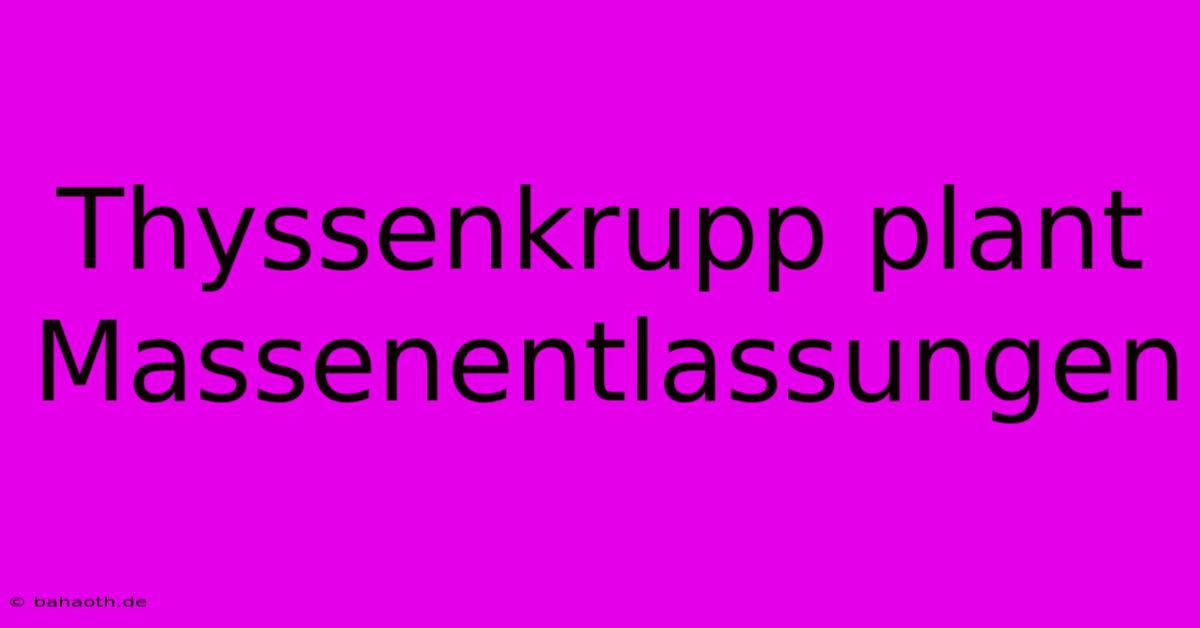Thyssenkrupp Plant Massenentlassungen

Discover more detailed and exciting information on our website. Click the link below to start your adventure: Visit Best Website Thyssenkrupp Plant Massenentlassungen. Don't miss out!
Table of Contents
Thyssenkrupp Plant Massenentlassungen: A Look at the Fallout and What It Means
Man, the news about Thyssenkrupp's mass layoffs hit me hard. I remember reading about it – Massenentlassungen – the sheer scale of it, thousands of jobs on the line. It felt like a punch to the gut, honestly. I've been following the steel industry for years, and this felt…different. It wasn't just another restructuring; it felt like a seismic shift.
The Human Cost of Restructuring
This isn't just about numbers on a spreadsheet, you know? These are people. Families. Livelihoods. I've seen firsthand the devastating impact of job losses – a friend of mine went through something similar years ago. The stress, the uncertainty…it's brutal. It completely upended their life, and it took years to recover. That's why I felt compelled to write this – to explore what's happening at Thyssenkrupp and what it might mean for the future.
Thyssenkrupp's announcement wasn't unexpected, of course. The steel industry's been struggling for a while now. Global competition, fluctuating raw material prices, and the push for greener technologies—it's a perfect storm. But still, the sheer number of planned layoffs was shocking. They've cited the need to streamline operations and improve profitability, but it’s a bitter pill to swallow for those affected.
Understanding the Impact: Beyond the Headlines
The immediate impact is obvious: unemployment. But the ripple effects are far-reaching. Think about the local communities dependent on Thyssenkrupp. Businesses that rely on the plant's workforce will suffer, and the overall economic health of the region will likely take a hit. It's a domino effect, and it's scary.
We need to look beyond the immediate financial implications, too. The psychological toll on those who lose their jobs can be significant. Increased stress levels, anxiety, and depression are common. The social impact is also considerable, with potential increases in crime rates and social unrest in affected areas. This isn't just an economic problem; it's a social crisis.
What Can Be Done? A Look at Potential Solutions
So, what can be done? This is where things get tricky. Retraining and reskilling initiatives are crucial. The government needs to step in and support these programs, helping displaced workers acquire new skills for emerging industries. There's talk of investment in green technologies within the steel sector – perhaps that's a path forward for some workers, though it might require significant retraining.
There's also a need for robust social safety nets – unemployment benefits, job placement services, and mental health support are all vital. Furthermore, early intervention is crucial. Helping those impacted by job losses to navigate the maze of support services and develop coping mechanisms will significantly reduce the longer-term impact. Long-term economic planning needs to focus on diversification of industries and regions, reducing dependence on sectors like steel that are prone to drastic downturns. This requires a multifaceted approach, involving collaboration between government, industry, and affected communities.
This isn't going to be a quick fix. The Thyssenkrupp situation is a stark reminder of the challenges facing the industrial sector and the importance of proactive measures to address the social and economic implications of major restructuring. It's a tough situation, but we need to be realistic and tackle this head-on. Let's hope we learn from this and avoid similar crises in the future.

Thank you for visiting our website wich cover about Thyssenkrupp Plant Massenentlassungen. We hope the information provided has been useful to you. Feel free to contact us if you have any questions or need further assistance. See you next time and dont miss to bookmark.
Featured Posts
-
Ehemann Missbrauchte 20 Jahre Haft
Nov 26, 2024
-
Spd Nominiert Scholz Als Kanzler
Nov 26, 2024
-
Oerlikon Kurs Rutscht Ab
Nov 26, 2024
-
Weniger Raclette In Walliser Restaurants 37 Zeichen
Nov 26, 2024
-
Jobs Bei Thyssenkrupp Drohende Kuendigung
Nov 26, 2024
